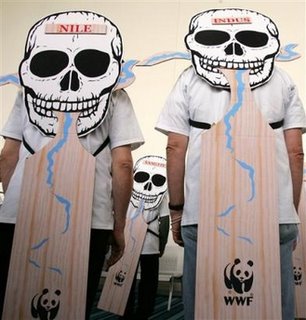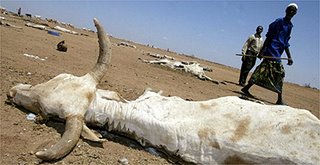
The Darling River in Australia as it looks today.
Unbelievable.
Outback Spirit Dries Up In Face Of Record Drought
By Nick Squires in Bourke
Last Updated: 3:54am GMT 20/11/2006
One of the most celebrated Outback towns has been pushed to the brink of social and economic collapse as a result of the worst drought in Australia's history.
Bourke, in the parched west of New South Wales, was enshrined in frontier mythology by 19th-century bush poets such as Henry Lawson, who declared: "If you know Bourke, you know Australia."
The expression "back o'Bourke" is understood by all Australians to mean in the middle of nowhere.
But the town's resilience has been pushed to breaking point by six years of drought, the worst "big dry" since the British settled in Australia in 1788.
Unless the drought breaks soon, Bourke will become "an economic and social disaster" according to a recent report by economists at Charles Sturt University in New South Wales.
The drought is taking its toll on towns across the Outback, but its effect on Bourke, 485 miles north west of Sydney, is particularly acute.
Unlike other towns in the bush, Bourke has no mining to fall back on. Its reliance on irrigation for vast cotton fields and citrus plantations also makes it vulnerable to the lack of rain.
The town's lifeblood, the Darling River, is dwindling by the day beneath a blazing blue sky, its sluggish waters an unhealthy pea green.
"This used to be a good fishing spot, but look at it now," said publican Lachlan Ford, surveying a section of the river, reduced to a patchwork of sandbanks, gravel shoals and fetid black pools. "We're coming into summer, when the temperature won't dip much below 40C for three months," he added.
There has been no cotton crop for three years because of the lack of water and the orange orchards are dying.
Kangaroos lie panting on a lawn in front of an office building on the outskirts of town and a pair of emus barely manage to break into a run when startled by the side of the road.
Without sufficient grazing, farmers have had to either sell all their sheep and cattle or buy in fodder at great expense. Sixty pastoral stations in the Shire of Bourke – an area about the size of Denmark – have no animals left at all.
Desperate graziers have taken to rounding up the flocks of feral goats that inhabit the scrub. Until recently dismissed as pests, they are now the only thing left to sell.
"Our dams [reservoirs] are depleted and we're running out of water," said Graham Brown, 58, who owns a 430,000-acre farm 190 miles west of Bourke.
"We're holding on by the skin of our teeth, but if we don't get any rain this summer, we'll be hitting the panic button."
Bourke's population has dropped in the last three years from 3,500 to less than 3,000. Shops on the main street are boarded up and houses are for sale.
"This is the worst drought white men have seen in this country," said mayor Wayne O'Mally. "It's really testing people's resources."
The drought has prompted an intense debate in Australia about the effects of global warming and whether some areas are becoming too dry for farming.
The government, which refuses to sign the Kyoto Protocol, insists there is no proven connection between climate change and the present drought. Scientists disagree. While the debate rages, the people of the Outback can only look to the skies and pray for a change in the hot, dry weather.
~~~~~~~~~~~~~~~~~~~~~~~~~~~~~~~~~~~~~~~~~~~~~~~~~~~~~~~~~~~~
And while this goes on, PM Howard meets with the coal industry to secure his campaign coffers. Disgraceful.
The Darling River which is the longest river in Australia and has six other rivers as tributaries is at dangerously low levels due to overuse of its waters, pollution from toxic runoff, and the most severe and prolonged drought in over a hundred years due in part to anthropogenic climate change.
Right now what Australia needs is not political posturing, but definitive action to mitigate this crisis and bring hope and sustinence back to the people of Bourke and other areas affected by it. And people NEED TO CHANGE THEIR WAYS as well, because as the Darling River crisis shows, mismanagement and misuse of water resources especially in light of the scientific consensus regarding climate change is not only irresponsible, but deadly.
In the words of Henry Lawson:
The skies are brass and the plains are bare,
Death and ruin are everywhere;
And all that is left of the last year's flood
Is a sickly stream on the grey-black mud;
The salt-springs bubble and the quagmires quiver,
And this is the dirge of the Darling River.
Is that really the legacy PM Howard wants to be remembered for?
Also see:
Darling Dry As A Bone
Threatened Species Of The Darling River









